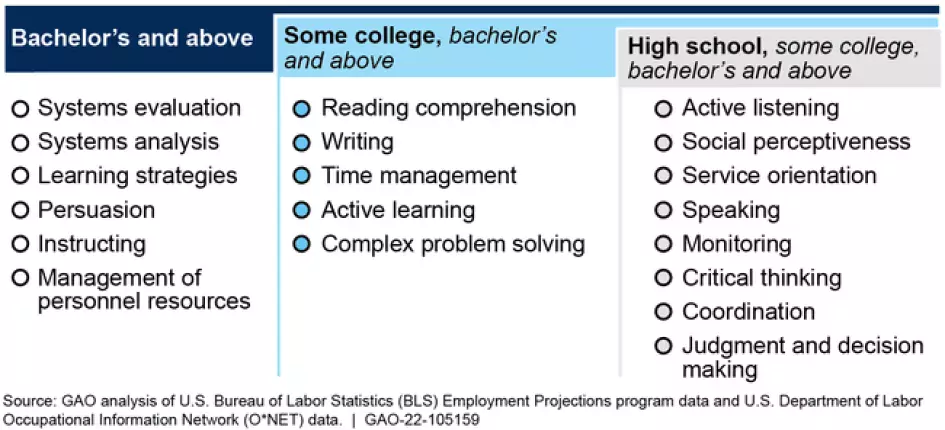Which Workers Are the Most Affected by Automation and What Could Help Them Get New Jobs?
Self-checkout at the grocery store, electronic record keeping, even tax preparation. Increasingly, technology is automating tasks previously performed by people. While automation technology has changed some jobs, it has eliminated others entirely.
Today’s WatchBlog post looks at our new report about which kinds of workers are most at risk of losing their jobs to automation, and what skills they need to get in-demand jobs.
You can also listen to our podcast with GAO’s Dawn Locke, an expert on workforce training and education, to learn more.
Image

Who is at risk of losing their job to automation?
Workers with lower levels of education and who perform routine tasks—think cashiers or file clerks—face the greatest risks of their jobs being automated. However, automation is likely to have widespread effects. Researchers estimate that anywhere from 9% to 47% of jobs could be automated in the future.
To better understand the scope of automation’s effects, federal agencies are working to gather more data on how automation will affect the workforce. For example, the Department of Labor is planning to gather information from industries such as retail trade, healthcare, and transportation and warehousing to learn more about how automation is affecting jobs.
What are the in-demand skills for in-demand jobs?
Workers impacted by automation may need new skills to adapt to changing job requirements or get a new job.
The Department of Labor’s data indicate that the skills needed for in-demand jobs (meaning those jobs projected to grow fastest in the next 10 years) will include a mix of:
- soft skills—like interpersonal skills to successfully interact with people,
- process skills that help a person acquire knowledge quickly—like active learning and critical thinking, and
- specific technical expertise skills—like equipment maintenance.
The Department of Labor’s data also show that in-demand jobs with a greater number of “important” skills tend to require more education. Important skills include active listening, social perceptiveness, and critical thinking.
Skills Deemed Important in the Top 20 In-Demand Occupations, by Education Level
Image

What challenges do workers face in getting those skills?
While research indicates that some in-demand jobs with skills like judgement and management might be more resistant to automation, workers trying to grow their skills face challenges.
For example, workforce stakeholders we interviewed for our new report told us that training programs sometimes focus on helping people get a job quickly, which could lead to a short-term or low-wage job. Others told us that workers face challenges accessing programs—for example, finding childcare or being in a training program without having a way to still pay bills.
How can organizations help workers overcome those challenges?
Workforce stakeholders we interviewed had a number of suggestions to address these challenges. For example, some stakeholders said that training programs should focus on in-demand skills needed for high-growth jobs that are less likely to be automated.
Research also noted that training should build on workers’ existing skills to help them build skills toward high quality jobs. Other stakeholders said training programs should help workers obtain industry-recognized credentials. Stakeholders also suggested that providing wraparound services, like childcare, and offering financial support can help workers access training, though they acknowledged the cost of that help.
Learn more about our work on automation and workforce development by checking out our new report and podcast, and our Key Issue page on Employment in a Changing Economy.
- Comments on GAO’s WatchBlog? Contact blog@gao.gov.
GAO Contacts
Related Products

GAO's mission is to provide Congress with fact-based, nonpartisan information that can help improve federal government performance and ensure accountability for the benefit of the American people. GAO launched its WatchBlog in January, 2014, as part of its continuing effort to reach its audiences—Congress and the American people—where they are currently looking for information.
The blog format allows GAO to provide a little more context about its work than it can offer on its other social media platforms. Posts will tie GAO work to current events and the news; show how GAO’s work is affecting agencies or legislation; highlight reports, testimonies, and issue areas where GAO does work; and provide information about GAO itself, among other things.
Please send any feedback on GAO's WatchBlog to blog@gao.gov.




